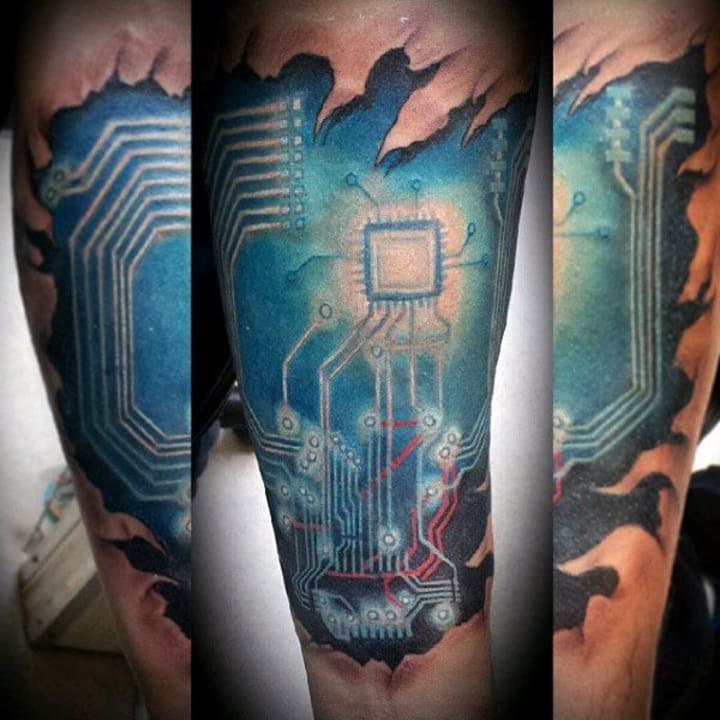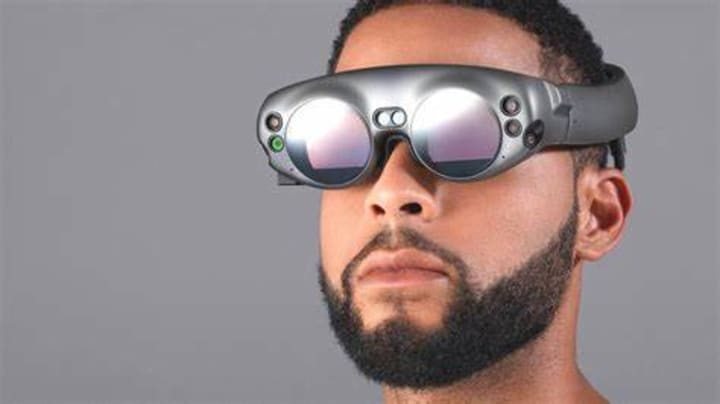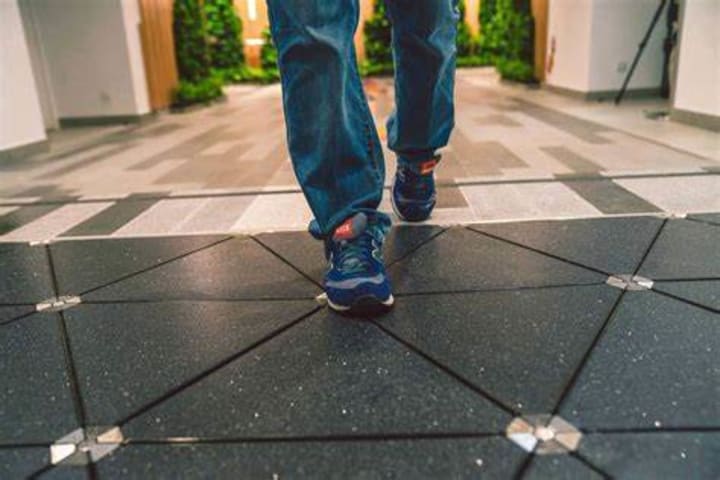11 Invention that will change the world
will change the world in the future!

1., Electronic tatoo:

Electronic tattoos, also known as e-tattoos or smart tattoos, are a new category of wearable devices that can be directly applied to the skin like a temporary tattoo. They are designed to be lightweight, flexible, and comfortable to wear, and they offer a wide range of applications, from health monitoring to personal authentication.
Electronic tattoos typically consist of a thin, stretchable film made from materials such as silicone, rubber, or plastic, that is embedded with electronic components such as sensors, antennas, and microprocessors. These components can collect data, such as body temperature, heart rate, and other biometric signals, and transmit it wirelessly to a smartphone or other mobile device.
One of the key advantages of electronic tattoos is their ability to conform to the contours of the skin, making them more comfortable to wear than traditional wearable devices such as smartwatches or fitness trackers. They can also be customized to fit the specific needs of individual users, such as athletes or medical patients.
In terms of applications, electronic tattoos have a wide range of potential uses. For example, they could be used to monitor health conditions such as diabetes or hypertension, providing real-time feedback to patients and healthcare providers. They could also be used for personal authentication, such as replacing traditional passwords or key fobs for access control.
Another potential application is in the field of augmented reality, where electronic tattoos could be used to provide a more immersive experience by embedding sensors and actuators that respond to user movements or other environmental stimuli.
Overall, electronic tattoos represent an exciting new frontier in wearable technology, offering a range of benefits over traditional devices in terms of comfort, flexibility, and customization. While still in the early stages of development, they are likely to become increasingly popular in the coming years as more applications are discovered and the technology becomes more advanced.
2., Recreating extinct animals:

Recreating extinct animals has long been a topic of interest and controversy in the scientific community. Advances in genetic engineering and cloning technologies have made it possible to extract DNA from fossils and attempt to bring extinct species back to life. While the idea of resurrecting extinct species may sound like science fiction, it is now becoming a reality, and it has the potential to change the world in significant ways.
One of the primary benefits of recreating extinct animals is the potential for restoring damaged ecosystems. Many extinct species played critical roles in their ecosystems, and their absence has had far-reaching impacts on other species and the environment. By bringing these species back to life, scientists hope to restore ecological balance and preserve biodiversity.
For example, the woolly mammoth, which went extinct over 4,000 years ago, played a crucial role in maintaining the Arctic tundra ecosystem. Their grazing helped to maintain the grasslands, preventing the tundra from becoming a forest. Bringing back the woolly mammoth could help to restore the Arctic tundra and combat climate change by reducing the amount of carbon released from the melting permafrost.
Another potential benefit of recreating extinct animals is the opportunity to study and learn from these species. Scientists could gain valuable insights into the biology and behavior of these species, which could help to inform conservation efforts and aid in the protection of endangered species.
However, there are also significant ethical and environmental concerns surrounding the recreation of extinct animals. Critics argue that the focus should be on preserving existing species rather than bringing back extinct ones, and that the resources and funding used for these projects could be better spent on conservation efforts.
Additionally, there are concerns about the potential impacts of reintroducing these species into modern ecosystems. The ecosystems in which these species once existed have changed significantly, and it is unclear how they would fit into the modern world. There are also concerns about the potential for these species to introduce new diseases or disrupt existing ecosystems.
In conclusion, the recreation of extinct animals has the potential to change the world in significant ways, both positive and negative. While there are many potential benefits to restoring lost biodiversity and restoring ecosystems, there are also significant ethical and environmental concerns that must be addressed. As this technology continues to advance, it will be important for scientists, policymakers, and the public to carefully consider the implications of resurrecting extinct species and to ensure that these efforts are undertaken with caution and responsibility.
3., AR glasses:

Augmented Reality (AR) glasses are a type of wearable technology that overlays digital information onto the real world. Unlike virtual reality (VR) headsets, which create entirely immersive environments, AR glasses enhance the user's perception of reality by adding computer-generated graphics, images, and information to the environment around them. The technology has the potential to revolutionize the way we interact with the world and with each other, and it is already being used in a wide range of applications.
AR glasses typically consist of a pair of glasses or goggles with built-in cameras, sensors, and displays. The cameras capture the user's surroundings, and the sensors track the user's movements and location. The displays then overlay digital images onto the real-world environment, creating a seamless augmented reality experience.
One of the primary benefits of AR glasses is the ability to provide users with information in real-time, without the need for a separate device or screen. For example, AR glasses could be used by workers in manufacturing or construction to display instructions or schematics directly in their field of vision, reducing the need to constantly refer to manuals or blueprints.
AR glasses can also be used for entertainment and gaming. For example, games could be created that allow users to interact with virtual objects and characters in the real world. This has the potential to create entirely new forms of entertainment and could revolutionize the gaming industry.
Another potential application for AR glasses is in education and training. For example, medical students could use AR glasses to simulate surgical procedures, providing a realistic and interactive training experience. Similarly, AR glasses could be used to teach geography, history, or other subjects by overlaying digital information onto real-world landmarks or objects.
AR glasses also have the potential to change the way we interact with each other. For example, AR glasses could be used to provide real-time translation of foreign languages, allowing people from different countries to communicate more easily. AR glasses could also be used to provide a virtual meeting space, allowing people to interact with each other in a shared virtual environment.
Overall, AR glasses have the potential to change the world in significant ways by providing users with new ways to interact with the world and with each other. As the technology continues to advance and become more widespread, it is likely to have a major impact on industries ranging from entertainment and gaming to education and healthcare.
3., Pavegen:

Pavegen is a technology company that specializes in creating sustainable energy solutions. The company has developed a unique flooring system that generates electricity from the kinetic energy produced by footsteps. The technology is known as Pavegen, and it has the potential to transform the way we think about energy generation.
The Pavegen system consists of a series of floor tiles that are designed to flex slightly when stepped on. When the tiles flex, they generate a small amount of electricity, which is stored in batteries or used to power nearby devices. The system is designed to be used in high-footfall areas such as public spaces, sports stadiums, and shopping centers.
One of the primary benefits of the Pavegen system is its ability to generate electricity from a completely renewable source: human footsteps. By harnessing the kinetic energy produced by foot traffic, the system can provide a sustainable and reliable source of power. The system can also be used to collect data on foot traffic patterns, which can be used to optimize the design and layout of public spaces.
The Pavegen system has already been installed in a number of high-profile locations, including Heathrow Airport in London and the BNP Paribas tennis tournament in Paris. In addition to generating electricity, the system has been used to power lighting, charging stations for mobile devices, and even interactive displays that respond to foot traffic.
The potential applications for the Pavegen system are vast. In addition to public spaces and sporting events, the system could be used in schools and universities to educate students about sustainable energy generation. It could also be used in remote areas that lack access to traditional power sources, providing a sustainable source of energy for communities.
Overall, the Pavegen system has the potential to transform the way we think about energy generation and sustainability. By harnessing the power of human footsteps, the system provides a unique and sustainable source of electricity that could be used to power a wide range of devices and applications.
5., Self healing concrete:

Self-healing concrete is a revolutionary material that has the ability to repair its own cracks without any human intervention. The technology behind self-healing concrete has the potential to significantly increase the lifespan of concrete structures, reduce maintenance costs, and improve safety in the built environment.
Traditional concrete is prone to cracking over time due to various factors such as weather conditions, heavy loads, and shrinkage. These cracks can lead to structural damage, reduced durability, and corrosion of the steel reinforcement inside the concrete. Repairing these cracks is a time-consuming and expensive process, and it can also disrupt the functionality of the structure.
Self-healing concrete is made by incorporating capsules containing a healing agent into the concrete mixture. These capsules rupture when the concrete cracks, releasing the healing agent into the crack. The agent then reacts with the water and air in the environment to form a solid material that fills the crack and restores the structural integrity of the concrete.
There are several types of healing agents that can be used in self-healing concrete, including bacteria, fungi, and synthetic materials. Bacteria-based healing agents use a microorganism that produces calcium carbonate when exposed to water and air. Fungi-based healing agents use spores that germinate when exposed to water, forming a network of fungal hyphae that secrete calcium carbonate. Synthetic healing agents can also be used, such as microcapsules containing polymer or epoxy resins that harden upon contact with the air.
The benefits of self-healing concrete are significant. The technology can extend the lifespan of concrete structures, reducing the need for costly repairs and replacements. It can also improve safety by preventing structural failures due to cracks, and reduce maintenance costs by minimizing the need for regular inspections and repairs.
6., Floating farms:

Floating farms are a type of agricultural production system that involves growing crops or raising animals on water bodies, such as rivers, lakes, and oceans. These farms are typically built on floating platforms made of a variety of materials such as bamboo, wood, or concrete, and can be anchored or moored in place.
There are several advantages to floating farms. For one, they can provide an efficient use of space, particularly in densely populated coastal areas where land for traditional agriculture may be limited. Additionally, floating farms can be used to cultivate crops or raise animals in areas where land-based farming is difficult or impossible due to factors such as flooding or soil infertility.
Another advantage of floating farms is that they can be designed to be environmentally sustainable, with systems for recycling waste and capturing and utilizing rainwater. In some cases, floating farms can also provide habitat for marine life and help to reduce water pollution.
Floating farms can be used to produce a variety of crops, including vegetables, fruits, and grains. Aquaculture, or the farming of fish and other aquatic animals, is also a common use of floating farms. In addition to providing food, floating farms can also be used for research and educational purposes, and can serve as a tourist attraction.
Overall, floating farms are an innovative and promising approach to agricultural production that can help to address food security, environmental sustainability, and other global challenges.
8., 3D printed bones:

3D printing is a technology that allows for the creation of three-dimensional objects by layering materials on top of each other based on a digital design. In recent years, 3D printing has been increasingly used in the medical field, including the production of 3D printed bones.
3D printed bones are created by using computer-aided design (CAD) software to create a digital model of the bone. This model is then translated into a format that can be read by a 3D printer. The 3D printer then uses a variety of materials, such as plastic or metal, to create the bone layer by layer.
One of the advantages of 3D printed bones is that they can be customized to fit the specific needs of a patient. For example, if a patient needs a bone replacement due to injury or disease, a 3D printed bone can be created to match the exact size and shape of the missing bone. This can help to reduce the risk of complications and improve patient outcomes.
Another advantage of 3D printed bones is that they can be produced more quickly and at a lower cost than traditional bone replacements. This is because the digital design can be created and modified quickly, and the 3D printer can produce the bone in a matter of hours.
While 3D printed bones show great promise, there are still some challenges that need to be addressed. One of the main challenges is ensuring that the 3D printed bone is strong enough to withstand the stresses of everyday use. Additionally, there is a need for further research into the long-term safety and effectiveness of 3D printed bones.
Overall, 3D printed bones have the potential to revolutionize the field of orthopedics and improve patient outcomes. As the technology continues to evolve, it is likely that 3D printed bones will become an increasingly common solution for bone replacement and repair.
9., Fire fighting with sound:

Firefighting with sound is a new and emerging technology that uses low-frequency sound waves to extinguish fires. This technology has the potential to revolutionize firefighting by providing a safer and more effective way to put out fires.
The principle behind firefighting with sound is that sound waves can disrupt the air surrounding a fire, causing the flames to be extinguished. The sound waves essentially push air away from the fire, depriving it of the oxygen it needs to burn. Low-frequency sound waves, in particular, are effective at disrupting the air surrounding the fire, as they can travel longer distances and penetrate deeper into materials.
One advantage of firefighting with sound is that it can be used in situations where traditional firefighting methods may not be effective or safe. For example, it can be used in environments where water or chemical agents may be hazardous, such as around electrical equipment or in confined spaces. It can also be used to control fires in areas where access is limited, such as in forests or on oil rigs.
Another advantage of firefighting with sound is that it can be used to extinguish fires more quickly than traditional methods. The sound waves can be directed to specific areas of the fire, allowing for more targeted extinguishing. This can help to reduce the amount of damage caused by the fire and increase the safety of firefighters and other first responders.
While firefighting with sound is still in the experimental stage, initial tests have shown promising results. Researchers are continuing to develop and refine the technology, and it is possible that it could become a common firefighting tool in the future.
10., Wireless screen:

A wireless screen is a display that can receive and display content wirelessly without requiring any cables or physical connections. This technology is commonly used for presentations, entertainment, and collaboration in both personal and professional settings.
One advantage of wireless screens is that they are highly portable and can be easily moved between locations without the need for complex cabling or setup. This makes them ideal for use in conference rooms, classrooms, and other settings where multiple users may need to share content on a display.
Another advantage of wireless screens is that they can support multiple devices simultaneously, allowing users to switch between devices and share content seamlessly. This can be particularly useful in educational settings, where multiple students may need to share content from their own devices.
Wireless screens also offer increased flexibility and convenience compared to traditional wired displays. Users can share content from their smartphones, tablets, or laptops with ease, without having to physically connect their devices to the display. This can save time and reduce the clutter of cables and adapters.
Wireless screens can also improve collaboration and productivity in the workplace. Teams can easily share ideas, collaborate on documents, and give presentations without the need for complex cabling or equipment. This can lead to increased efficiency and better communication among team members.
In addition, wireless screens can provide a more streamlined and visually appealing setup for entertainment purposes. Users can wirelessly stream content from their smartphones, tablets, or laptops to the display, creating a more immersive and enjoyable viewing experience.
Overall, wireless screens offer numerous advantages over traditional wired displays, including portability, flexibility, and increased collaboration and productivity. As this technology continues to evolve and improve, it is likely that wireless screens will become an increasingly common solution for display and presentation needs.
About the Creator
Enjoyed the story? Support the Creator.
Subscribe for free to receive all their stories in your feed. You could also pledge your support or give them a one-off tip, letting them know you appreciate their work.






Comments (1)
Read out on Futurism https://vocal.media/futurism/from-dreamers-to-achievers